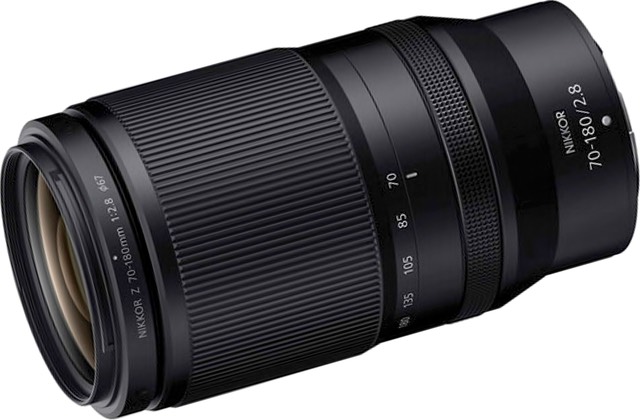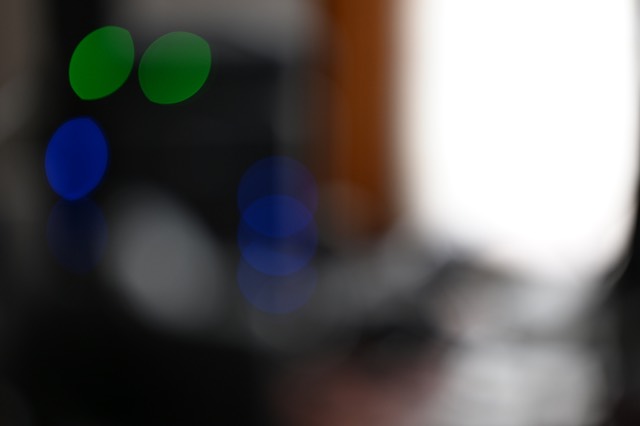
What Is It?
With the 70-180mm f/2.8 Nikon completes their Tamrikon trio of more affordable fast zoom lenses (17-28mm, 28-75mm, and 70-180mm). These lenses share a 67mm filter size, as well as over compactness and weight saving from the 14-24mm, 24-70mm, and 70-200mm f/2.8 S lenses.
The original design of these lenses was Tamron’s own (e.g. 70-180mm f/2.8 Di III VXD). The Nikon versions of the lens trio differ in appearance and lens mount and focus motor, but otherwise seem identical. Note: Tamron has made a development announcement of a G2 version of the lens for Sony FE mounts, which includes a stabilization feature. It's doubtful that Nikon will update their version of the 70-180mm f/2.8 any time soon.
Both the current Tamron and Nikon version of the 70-180mm feature 19 elements in 14 groups. Both have three aspherical, one Super ED, and five ED elements, and these are oriented the same in both lenses. The aperture diaphragm is 9-blade. However, one difference is that the Nikon version has a minimum focus distance that produces about a 1:2 maximum magnification ratio in autofocus (the Tamron can hit that in manual focus, but not autofocus). Another difference is that the Nikon version can accept Nikon teleconverters (the Tamron Sony mount version doesn’t). So it’s clear just in the specifications that there some changes from the original A056 lens Tamron made.
Overall size is 5.9” (151mm) in length and 3.3” (83.5mm) in diameter, with a weight of 27.7 ounces (795g). By comparison, the Nikon 70-200mm f/2.8 VR S is 8.7” (220mm) long and 3.5” (89mm) in diameter, with a weight of 48 ounces (1360g) without the tripod collar. Thus, like the other Tamrikon lenses now in the Z-mount, you see a consistent “smaller, lighter, but with some compromise” philosophy at the core.
One such compromise is that the 70-180mm f/2.8 doesn’t have in-lens VR. Instead, it’ll rely upon sensor-VR to do any stabilization, which will have reduced effect at 180mm compared to the 70-200mm f/2.8 VR S’s internal VR. Another compromise is that the 70-180mm f/2.8 doesn’t come with or support a tripod collar, where its bigger brother does.
I mentioned focus. It’s important to note that minimum focus distance changes with focal length on this lens. It’s 11” (.27m) at 70mm, and 33” (.85m) at 180mm. That probably won’t be of consequence to most people, however if you’re moving within that one to three foot range and trying to keep the same focal length, you may have focus issues. However, maximum magnification stays at just about 1:2 throughout the range, which puts this lens in the near macro range.
I note that there’s a difference in focus motor: the Nikon version of this lens uses a Nikon stepping motor (as do most other Nikkors). The Tamron version of the lens uses a linear motor (VXD). Focus on the Tamron version is a bit snappier, but focus speed on the Nikon version is more than respectable (see below).
Nikon supplies the usual soft lens pouch for the lens, as well as the HB-113 lens hood (which can reverse mount on the lens for travel). The lens features a zoom lock mechanism when the lens is collapsed (70mm), but no other controls other than the usual zoom and focus rings. Note that the lens is an “external zoomer”, meaning that it extends as you zoom in. Overall, this extension amounts to about 1.2” (30mm). The actual zoom is done in about a 90° rotation of the zoom ring.
The Nikon 70-180mm f/2.8 lens claims dust and drip resistance in the build, comes with an HB-113 lens hood, and is made in China and sells for US$1250.
Source of the reviewed lens: purchased
How's it Handle?
TlslsNot much to say. The lens does feature a focal length lock that can be engaged when the lens is at 70mm (to keep the lens from extending during transport. The lens otherwise features Nikon-style zoom and focus rings, with the focus ring being closer to the camera.
You can use the Focus ring rotation range control on cameras that support that to adjust the focus ring's responsiveness. By default, the setting is usually Non-linear, but I found that using one of the shorter other options was preferable.
The zoom ring is furthest forward on the lens, very large, and easy to find. It's marked at 70mm, 85mm, 105mm, 135mm, and 180mm positions, and rotates from minimum to maximum focal length in less than a quarter turn. Again, note that this lens extends as you zoom in. At 1:2 and 180mm, this puts the working distance from the front of the lens at just over two feet (less if you count the lens hood).
How’s it Perform?
Focus: At 70mm I don’t think anyone’s going to say anything about negative about the focus performance, despite the use of the stepper motor. At 180mm, however, there’s a bit of slide-to-focus that’s visible in extreme focus changes. The lens still achieves quite respectable performance, though. The stepper noise is well subdued on this lens when focusing. Even in absolute quiet I sometimes have difficulty hearing it.
Focus breathing is suppressed, but not 100% tamed. Particularly at the 180mm focal length. What I see there is a very slight “zoom in” as you move from infinity to minimum focus (but remember, that’s nearly macro level), something less than 4% frame width overall. With more normal use of the lens, focus length breathing is not likely to be visible enough to worry about.
Sharpness: Up close (test chart range) and 70mm, you really need to be at f/5.6 to get excellent center and DX boundary results (full frame corners are fair+ at f/5.6 and require f/8 to get into the good range). At 85mm, the full frame corners start to catch up to the DX boundary (everything else is the same as at 70mm). The lens starts to come into its own at about 135mm, where I’d say that center to corners are excellent- at f/4. By the time you get to 180mm, things are starting to change again, with center excellent at f/4, but the DX boundary not reaching the same until f/8.
However, note that if you push the lens to the 1:2 magnification level at 70mm, the corners go decidedly soft, and even stopping down won't recover detail. At the other end of the focal range, I'd say that the corners can be recovered well by stopping down to f/5.6.

The lens at f/2.8 and pretty much minimum focus distance (handheld and the bee was moving, so can't say with certainty). Here's the 100% pixel view:

Contrast absolutely is enhanced by stopping down when in at close to modest distances, and my general advice is that if you’re looking for best edge to edge performance, you’re always going to want to be stopping down two stops, sometimes maybe three.
Things change a bit at distance. Curiously, the DX boundary area seems to suffer slightly at some focal lengths, but the full frame corners benefit at all of them. Overall, there’s a very strong benefit to stopping down to f/4 at any focal length, though two stops down is technically still the best choice. By “strong” I mean acuity and contrast clearly increase to the point where most would find the results more than acceptable. Since vignetting also comes into play (see below), the corner impression just is far better at distance when at f/4, to the point where I’d say center excellent, corners very good- at pretty much all focal lengths.
One thing I'd say is this: out through the DX boundary, the 70-180mm f/2.8 and the 70-200mm f/2.8 VR S are going to perform pretty similarly. The published MTF figures suggest this, and within my ability to discern, I'd say my results say that the 70-200mm f/2.8 VR S has more contrast at 70mm, and better performance from center to edge. That's not to discredit the 70-180mm f/2.8; it does quite respectably, but it's just never quite up to the level of its much more expensive brother at the shorter focal length. Plus, outside the DX boundary the lenses truly start to differ in ways you might be able to see.
At 180/200mm, the two lenses are closer in performance, though the 70-200mm f/2.8 VR S still has a bit more contrast. However, it would be difficult to discern which is which from even disciplined test chart photos other than that.
I'm not dissatisfied at all with the 70-180mm f/2.8 performance. But it's not all the way up to the level of the 70-200mm f/2.8 VR S, and no one expected it to be.
While you can use teleconverters on this lens, you’re going to go from excellent to very good- in the center, with similar drops in all the other aspects I’ve outlined above. The lens shows some spherical aberration, and putting a teleconverter on it is not going to help that.
Coma is decently handled, and essentially gone by f/4.
Chromatic Aberration: Surprisingly well controlled, for both longitudinal and lateral.
Vignetting: A pretty wide vignette free image circle produces very little vignetting at 70mm f/2.8 and essentially ignorable at f/4; Strong short axis vignetting of perhaps 2EV at 180mm f/2.8 which declines to almost ignorable at f/5.6. As usual, Nikon's in-camera vignette controls do not remove all of this vignetting, but do make the problem basically ignorable at all focal lengths.
Linear Distortion: You can't turn the distortion controls off for this lens, and the results are generally okay, with a very slight remnant pin-cushion as you zoom in. Raw processing in a program that doesn't understand or apply the corrections shows that the lens has a fairly high amount of pin-cushion distortion at 180mm, enough that you'd always want to correct it (e.g. >2%).
Flare: Clear ghosting artifacts with in frame or edge of frame light sources, though these tend to stay mostly green and don't go clearly prismatic as on some lenses. Contrast stays relatively high outside of the ghosting.
Bokeh: Minor cats eye that appears to be caused by light baffles wide open, and which increases to a more clear visibility as you zoom in. Some asymmetry to the diaphragm recording as you stop down (circle turns a bit elliptical). Minor outer brightness on specular highlights, but no apparent onion skinning internally (it's more a mottled appearance when provoked). Most will find the blurring in out of focus areas to be quite good, however, I'll note a couple of things to be aware of: blurring sometimes is stronger at corners of the frame, and sometimes a little busy and unnatural at close-in distances, particularly in front of the focal plane. Some are going to find the out of focus characteristics excellent, others will find the small faults, particularly at close focus distances, can be problematic at times.

The colored areas in the upper left should be spherical, not elliptical (cats eye).
Final Words
I’m really glad that Nikon produced the Tamrikon f/2.8 trio of lenses. In particular, the 17-28mm is an extremely good performer, and with some limitations, so is the 70-180mm.
One might argue whether or not Nikon should have made an f/4 trio instead, but given the smallish size and weight of these f/2.8 lenses, coupled with their shared 67mm filter size, I’m not sure how much would have been gained. Plus the extra stop is useful as the light goes down, not so much for shutter speed as it is for focus performance. If you used these lenses at f/4 lenses, you should be getting really nice results.
That said, the 70-180mm f/2.8 is clearly weaker at f/2.8 than the 70-200mm f/2.8 VR S, so if you’re needing edge-to-edge performance wide open all the time, this new 70-180mm f/2.8 might not be the right choice for you.
The full set of Tamrikon f/2.8 zooms strikes me as particularly intriguing and useful to the Z5 and Z6 crowd, both of whom would be more on a budget and less likely to see any compromises in image quality in the corners. A Nikon 24-70mm f/4 S and 70-180mm f/2.8 make for a pretty lithe two-lens set, and adding the 17-28mm f/2.8 or 14-30mm f/4 S would round you out very nicely from very wide to moderate telephoto, without breaking the bank.
DX users also might find the 70-180mm f/2.8 a useful addition, because it gives you a 105-270mm equivalent zoom that is actually quite good in the DX boundaries. Moreover, the smaller size and lighter weight (compared to the 70-200mm f/2.8 VR S) is decidedly more DX friendly. The bummer for DX users is that none of the current bodies nor this lens have VR, so you’d better be handling your camera well.
The 70-180mm f/2.8 should make everyone look a bit more questioningly at our 70-200mm f/2.8 VR S lenses. Yes, the latter is clearly better optically wide open and outside the central area, plus it has in-lens VR. But it just looks big and heavy in my safari bag compared to the 70-180mm f/2.8. Moreover, the 1:2 capability of the 70-180mm f/2.8 opens up potential new uses (though not without limitations). Simply put, the 70-180mm f/2.8 travels more friendly without making any deal-killing compromise.
But compromise it does. If corners need to be tight and controlled, particularly wide open and closer up, the 70-200mm f/2.8 VR S is the right option. If you need the best possible image stabilization, again the 70-200mm f/2.8 VR S is the right option. But absent that, most folk should be happy with the 70-180mm f/2.8, as will their bank account.
Recommended (2023 to present)
Support this site by purchasing from the following Web site:
